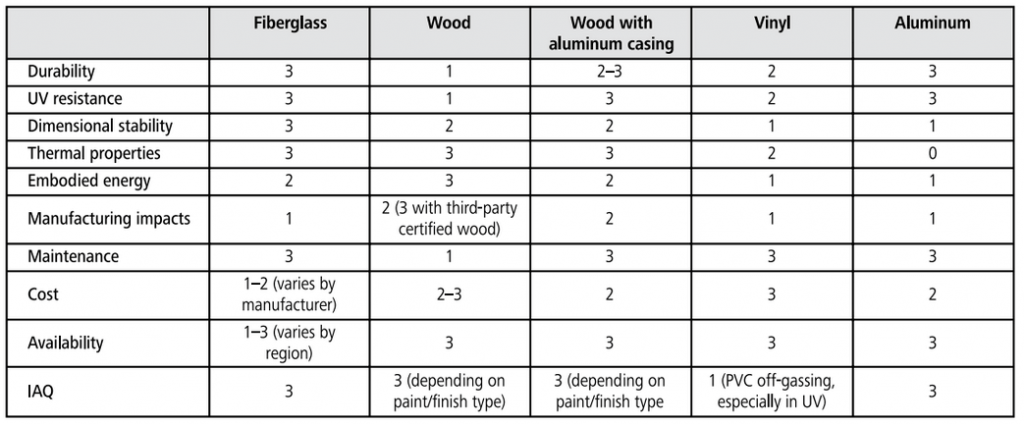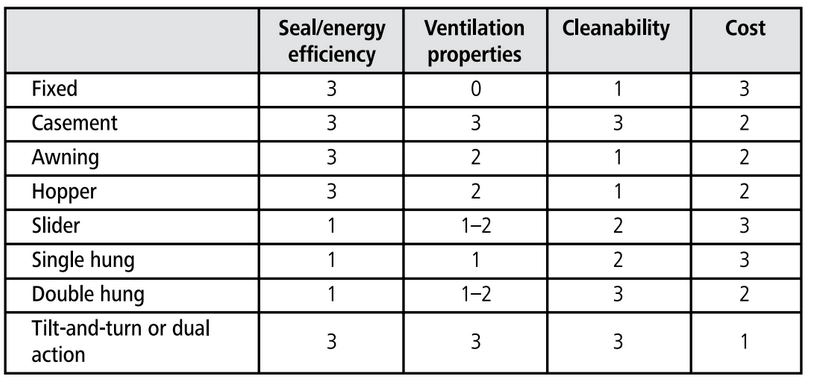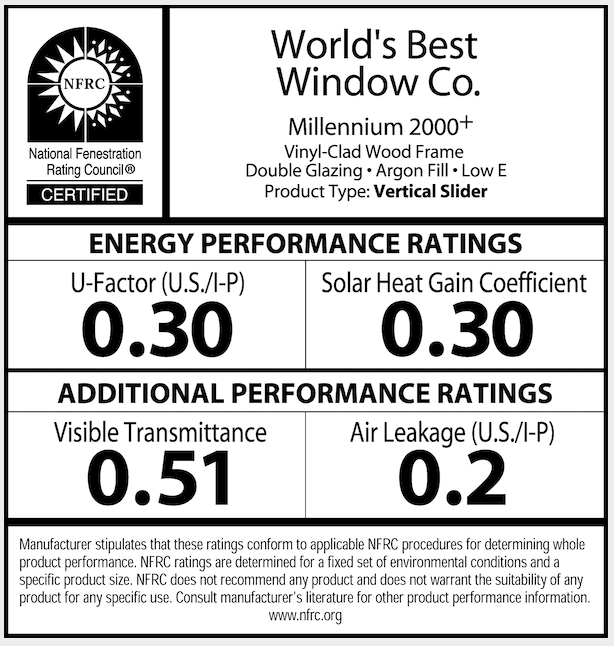WINDOWS
MATERIALS ENCYCLOPEDIA
Windows INTRO:
The most energy-efficient and inexpensive house to build would be a box with a single door and no windows. Windows are the weak link in the thermal performance of any building, as even the most expensive units are many times less thermally efficient than a regularly insulated wall. Windows are usually the main source of air leakage, both in the window unit and in the sealing details around the window. Window openings are often the places where water leaks into the enclosure as well.
Of course, we wouldn’t dream of having a home with no windows. For all the compromises they force on a building, the natural light, views, ventilation and connection to the outdoors are priceless.
There aren’t the same kinds of widely varying options available to homeowners when it comes to windows as there are for other elements of the home.
All windows operate on the same principle and differ only in a few important areas.
- Frame material
- Operational style
- Glazing layers
- Glazing coatings
- Spacer material
- Gas fill
- Thermally broken frame
- Exterior trim
- Interior trim
Retailers and consumers tend to differentiate windows mainly by the material out of which the frame and casings are made. These include:
1 – Worst
3 – Best

Window units can be ordered that have combinations of the different operational styles. Units can be side-by-side and/or vertically stacked to achieve a desired mix of ventilation and performance.

Single-pane windows are not accepted by codes for new construction. Double, triple and quadruple glazing layers are available, with cost, energy efficiency and weight increasing with each additional layer. Some triple- and quadruple-pane units use a clear plastic sheet as one of the central panes to reduce weight and increase thermal performance.
The term “Low-E” glass indicates that a low-emissivity coating has been applied to the glazing. The metallic coating reflects a percentage of the long-wave heat radiation striking the glass, helping to improve energy efficiency. There are actually two kinds of Low-E coating:
Hard-coat Low-E glass is made by pouring a very thin layer of molten tin over the glass while it is still slightly molten. The liquid tin welds to the molten glass, creating a coating that is very strong and scratch resistant. It has an R-value equivalent of 2.75.
Soft-coat Low-E glass has tin, silver or zinc applied to it in a vacuum chamber filled with an electrically charged inert gas. Atoms of the coating metal are sputtered on the surface of the glass. This coating is not very scratch resistant, and is always applied to an inward-facing pane. It has an R-value equivalent of 4.35.
Window units can be ordered with different coatings on different faces of the glazing, depending on whether they need to resist heat gain from the outside or heat loss from the inside.
The addition of Low-E coatings reduces the amount of light transmitted through the glass. For this reason, it is often omitted on windows where maximum solar gain is desired.
The spacers that separate the panes of glazing around the edges of the unit can be made from aluminum or from a variety of rubber or foam compounds. The more conductive the spacer material, the lower the thermal performance. Good “warm edge” spacers make a substantial difference in performance.
The space between glazing panes can be filled with an inert gas, either argon or krypton. These gasses are less conductive than air and help to minimize heat loss.
Very efficient windows have “thermally-broken” frames, ensuring that there is no part of the window unit that is continuous from the interior side to the exterior. The separation is usually made with rigid foam insulation.
A wide variety of exterior trim components can be attached to windows to suit different window depths, trim details, siding types and aesthetics.
Windows can be ordered with drywall return slots or wooden jamb extensions built in. These can speed up the finishing and trimming of the window opening.
Window labeling
 The Energy Star program provides a standardized window labeling program in the US and Canada, giving buyers key information for comparison between brands and models.
The Energy Star program provides a standardized window labeling program in the US and Canada, giving buyers key information for comparison between brands and models.
U-factor is the thermal resistance of the window. The lower the number, the better the thermal performance.
Solar heat gain coefficient is the amount of warming solar radiation that will make it through the glazing. The higher the number, the more solar heat will penetrate into the building.
Visible transmittance is the amount of the visible light spectrum that penetrates the window into the building. The higher the number, the more natural light.
Air leakage is tested by depressurizing the area behind the window to see how much air will infiltrate the unit. The smaller the number, the better the thermal performance.
Canadian windows will give these figures in metric measurements, and US windows in imperial. Be sure to convert if comparing between units from the different countries.
Choosing the best possible windows is a critical step in making an energy-efficient building. While it is not quite true to say that the more expensive the window the better its performance, it is true that high-performance windows will not be the cheapest option.
Consider glazing decisions at the design phase of the building, and discuss options with the window manufacturer. Good window design considers the type and placement of Low-E coatings, solar heat gain coefficient, visible transmittance, energy performance and ventilation requirements. A “one size/type fits every opening” approach is never the most efficient option.